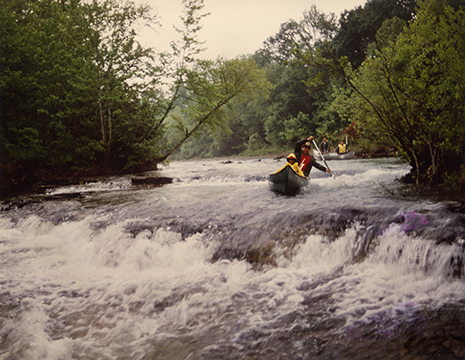
FAYETTEVILLE, Ark. –The University of Arkansas Libraries will celebrate environmentalism in the Natural State with an event titled “40-50-100: Milestones in Arkansas’s Environmental History” on from 3 p.m. to 4:30 p.m. Wednesday, September 19, in the Helen Robson Walton Reading Room in Mullins Library.
The event commemorates the 40th anniversary of the Buffalo River’s designation as a national river, the 50th anniversary of the founding of the Ozark Society environmental conservation group, and the 100th anniversary of the birth of Neil Compton, founder of the Ozark Society. The program begins with remarks by representatives of the Libraries, the Compton family, the Buffalo National River staff and the Ozark Society with a reception following. The event is free and open to the public.
Bentonville physician Neil Compton founded the Ozark Society in 1962 to promote the conservation of the surrounding Ozarks. The organization soon launched a campaign to preserve the Buffalo River as a free-flowing, undammed river. A proposal by the U.S. Corps of Engineers to build two dams on the river sparked a long and heated debate between the pro-dam proponents, such as the Buffalo River Improvement Association, and the anti-dam advocates, led by the Ozark Society.
“Dr. Neil Compton and the Ozark Society were at the forefront to keep dams off the free-flowing and pristine Buffalo River,” said Timothy G. Nutt, interim head of special collections. “Without these pioneers, generations of Arkansans would have been forever deprived of the river’s boundless beauty and thrilling adventure. I hope people will join us on September 19 to pay homage to these early leaders in Arkansas’s environmental movement.”
The Buffalo River became the first national river in U.S. history, largely due to the efforts of the Ozark Society. The river is one of the few remaining unpolluted, free-flowing rivers in the lower 48 states. The National Park Service administers 135 miles of the 150-mile long river that flows through Newton, Searcy, Marion and Baxter Counties. Originating in the Boston Mountains of the Ozark Plateau, the Buffalo National River offers historic sites depicting the cultural history of the river’s peoples, plus water activities, camping, hiking trails, caves, a diversity of plant and animal species and three congressionally designated wilderness areas. The river is fed by tributaries and springs, causing dramatic “pour-offs” down the limestone bluffs.
The Libraries’ special collections department holds a number of manuscript collections supporting research on the battle over the Buffalo, including the Ozark Society Records (MS OZ1 219, 219A-I Ozark and MC 477), the Neil Compton Papers (MC 1091), the Gus Albright Scrapbooks (MC 1295), the Kenneth L. Smith Papers (MC 1423), and the Margaret Hedges typescript reminiscence (MC 1203) of Supreme Court Justice William O. Douglas’s visit and canoe trip on the Buffalo River in 1962, which spurred the formation of the Ozark Society.
The event will feature an exhibit of photographs and documents from the Neil Compton and Ozark Society collections.
Contacts
Tim Nutt, interim head of special collections
University of Arkansas Libraries
479-575-8443, timn@uark.edu
Jennifer Rae Hartman, public relations coordinator
University Libraries
479-575-7311,
jrh022@uark.edu